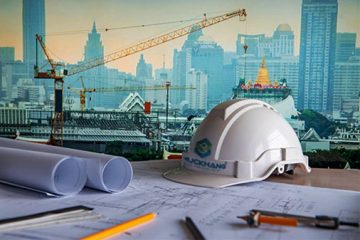The Construction sector is the second highest user of plastics after packaging.
Plastics are used in a growing range of applications in the construction industry. They have great versatility and combine excellent strength to weight ratio, durability, cost effectiveness, low maintenance and corrosion resistance which make plastics an economically attractive choice throughout the construction sector.
Plastics in construction are mainly used for seals, profiles (windows and doors), pipes, cables, floor coverings, and insulation. Potentially, plastics have further uses as they do not rot, rust or need regular re-painting, they have strength with lack of weight, they are easily formable, and their light weight enables them to be easily transported and moved on site.
Areas of Use:
Piping and Conduit
Piping and Conduit are the largest users of polymers in construction and consume 35% of production. Producing cabling, rainwater goods, large diameter pipes for sewage, drainage and potable water made from PVC and Polyethylene.
Cladding and Profiles
Cladding and profiles for windows, doors, coving, and skirting made from PVC-U, exterior cladding using phenolic is replacing timber rather than traditional resins which have a minimum fire risk.
Insulation
Insulation is generally produced from Polystyrene rigid foam which is incorporated into panels or sandwiched into construction of walls and roofs. The insulation combines lightness and strength and is simple to install, and enables contractors to meet energy conservation regulations.
Seals and Gaskets
Seals and Gaskets are made from Elastomers whose main construction use is for weather strips, aperture seals, gaskets and expansion joints. The polymers used are chloroprene and EPDM which have weatherability, resistance to deformation and retain elasticity, and PVC in windows and doors, also as a membrane for roofing and linings. In addition, 250,000 tonnes of polymers are used as a base for adhesive systems and sealants.
The construction industry has a tendency towards traditional materials, tried and tested methods and products – but plastics offer opportunities for innovation.
The future of the construction industry has always been dependent on economic conditions. Changes to the industry are now being accelerated through an increase in demand for housing coupled with new regulations which are intended to make the industry more energy efficient, manage waste, recycle and take LCA (life cycle analysis) into consideration.
The future will see the growth of intelligent buildings and methods such as prefabrication which will move work away from construction sites and into factories.
New materials and a range of polymeric composites and glass reinforced plastic materials have implications for structures. One of the principal advantages of plastics are their ability to be designed to a wider range of uses. Their resistance to corrosion, light weight and strength make the potentiality of load bearing structures as opposed to architectural features a possibility.

